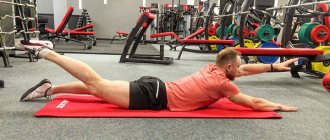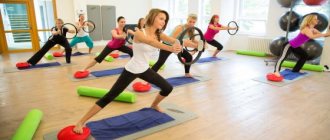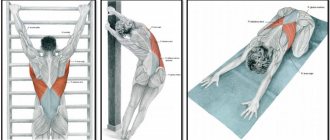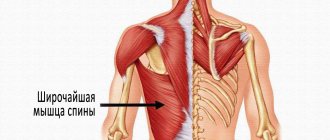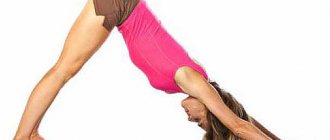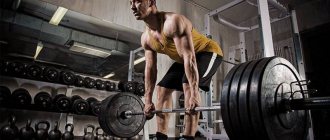Our body needs to be kept in good shape, this makes it age less and we get sick less often. The muscle corset must be strengthened so that your internal organs are reliably protected and your spine is in the correct position. The state of our posture depends on it; this problem is especially relevant for people with a sedentary work pattern. Today we will consider the importance of this muscle group and the consequences of its weakening.
You can keep your body in good shape by attending fitness classes, Pilates, and working out in the gym, but not all people are allowed such exercise by doctors. Today we’ll look at a set of exercises that anyone can do at home, without going to the gym or observing specialists.
Components of a muscle corset
Certain muscle groups need regular training to make them stronger and more resilient. The muscle corset consists of the following elements:
- The transverse muscle group that surrounds the body and is located in the abdominal region. Supports internal organs in their natural, physiological position, participates in the process of retraction and relaxation of the abdomen.
- Pelvic muscles, which include fascia, ligaments, and muscles.
- Fascia in the thoracolumbar region. These are connective tissues that are located between the pelvic region and the spinal column. They stabilize the spine and serve as its support.
- Multifidus muscles, which are localized in the posterior part of the spinal column. The spinal discs are fixed and the load is evenly distributed across each vertebra.
- The diaphragm is the area that regulates respiratory processes. Restores thoracic and abdominal pressure, stabilizes the spinal column and chest.
Lack of physical activity is fraught with loss of elasticity and performance of the muscle corset. This is accompanied by a feeling of pain and impaired mobility. The progression of osteochondrosis, hernias, arthritis, scoliosis begins, and the physiological location of the internal organs changes.
How to check the muscle corset?
To check the muscle corset, several basic tests are used:
- To check the stabilization of the spinal column, a person gets on all fours and rests his hands on the floor. It is necessary to keep your back and knees at right angles. Extend your left arm forward and right leg back, keeping it straight. Stretch your neck, point your head forward. Impaired balance indicates destabilization and weakness of muscle tissue.
- A person lies on his back on a hard surface, lifts his limbs up. The stomach is pulled in, the core muscles are tense. The chest begins to rise with an arched back. You must hold this position for at least 60 seconds. If less time has passed, then the muscle tissue needs to be worked out.
The condition of the muscle corset depends on the degree of mobility, a person’s lifestyle, and body weight. In addition to physical activity, it is necessary to adjust the diet and introduce a sufficient amount of nutrients into it: protein, fats, vitamins, minerals.
The most effective exercises to support the muscular corset
The spinal column includes movable elements - vertebrae with discs that absorb shock. The vertebrae and intervertebral discs are the basis that provides balanced curves and mobility of the spine. A healthy back means elastic, flexible discs and good condition of muscle tissue.
To support their health, it is recommended to regularly perform a set of specially designed exercises. They are classified into several main groups:
- stretching exercises - for slow, static stretching of muscles;
- strength training - systematic repetitions of contraction of muscle tissue, until they are completely tired;
- performing aerobic exercises that involve large areas of muscle tissue.
At the initial stages, it is recommended to conduct training under the supervision of an experienced, qualified instructor. A specialist will help you choose an individual set of exercises and hone the correct technique for performing them. In the future, you can study on your own. The workout takes place at a comfortable pace, without wear and tear. There should be no pain or discomfort.
Strength training
Strength loads quickly strengthen muscle tissue, increasing their tone, and increasing endurance. Harmonious development of the back muscles and abs helps maintain an even posture. The following exercises are recommended:
- Upper abs crunches. The person takes a horizontal position on a flat, hard surface (the floor), puts his arms along his body, and bends his legs at the knees. To eliminate the arch in your back, you need to press your pelvis tightly. Next, you need to lift your shoulder blades off the floor and hold in this position for up to 15 seconds. Repeat at least 5 times.
- Twisting the oblique muscles. You need to lie on the floor, raise your head and move your shoulder towards the opposite hip, stretching your arms forward. Hold for 15 seconds. Repeat 5-15 times in each direction.
- “Superman” - alternate lifts of the body to the left and right. You need to lie face down on the floor, place your arms along your body. Tighten your gluteal muscles, raise your head and stay in this position for up to 15 seconds. Repeat several times.
- Swing your arms and legs. You need to lie on the floor with a rolled cloth under your forehead. The arms are extended above the head; a small pillow can be placed under the pelvic area and stomach. Keeping your left leg straight, raise it a few centimeters from the floor, while simultaneously raising your right arm straight. Hold this position for up to 10 seconds. Repeat for the other side. Do 5-15 repetitions.
The exercises can be performed one at a time or included in your daily workouts all at once. The load should be feasible and moderate.
Stretching exercises
Stretching exercises help increase the flexibility of the intervertebral joints and pelvic area. This prevents abrasion of the articular surfaces and traumatic injuries during training. These exercises are recommended to be performed after intense training to prevent pain and overstrain of muscle tissue:
- Stand up straight, arms along your body. Bend back, arching your back. Maintain balance and stay in this position for up to 10 seconds. There should be no pain or discomfort. Repeat up to 7-15 times.
- Lie on your back, place your arms along your body. Pull your knees towards your chest until you feel a stretch in the lumbar region. Freeze in this position for 10 seconds. Do several approaches.
- Lie on your back, bend your knees. Raise one leg up, holding the back of your thigh. Try to straighten your leg and hold in this position for 10 seconds. Repeat for the other leg.
The described exercises are performed slowly, avoiding pain. It is necessary to stretch as much as individual training allows.
Aerobic exercise
During aerobic training, muscle tissue uses the energy generated by breaking down sugars with oxygen (aerobic glycolysis). Aerobic exercise involves a large number of muscles, putting stress on the heart and blood vessels. They are also called “cardio training”. The load on the joints is reduced, and movements are cyclical. Such exercises strengthen the back muscles, have a beneficial effect on the state of the cardiovascular system, respiratory organs, and increase endurance. The following sports are recommended as aerobic exercise:
- cycling;
- running;
- rowing;
- dancing;
- walking.
You can train several times a week. Walking at a fast pace in the fresh air is recommended daily: at least 10,000 steps. To determine the intensity of your exercise, it is important to monitor your heart rate. There is a formula for determining the maximum heart rate: 220 - a person’s age. Your heart rate should remain between 55-65% of your maximum heart rate.
Thanks to regular training, energy potential increases, mood improves, metabolic processes are restored, and excess fat is burned.
Many athletes note that performing aerobic exercises before strength training enhances the effect of burning fat and prevents overwork of certain muscle groups. It is important to avoid general fatigue and exhaustion.
To keep your back healthy and your posture straight and beautiful, it is recommended to exercise regularly, without skipping, choosing the most suitable, comfortable set of exercises for yourself.
General exercises to strengthen the muscle corset
Below is a mix of exercises that you can perform daily and supplement your regular exercises with them. They are easy to perform and suitable even for beginners.
- The plank can be performed at any time of the day; it is a simple and effective exercise. Body position as in push-ups. Push off the floor with your elbows and forearms. Bring your feet together, tense all muscle groups, pull in your stomach. Hold this position for 20 seconds to 2-3 minutes.
- The previous exercises can be supplemented by raising the straight leg up, above the shoulder line. The technique is similar. You can also move your legs to the side to enhance the effect.
- To strengthen the muscle corset and buttocks, walking on the buttocks is recommended. Starting position: sitting on the floor with your back straight. The abdominal muscles are tense. Slowly begin to “walk” your buttocks along the floor, covering at least 1.5 meters in one approach. It is important to ensure that your back is straight.
- Exercises on an unstable platform strengthen the core muscles and abs. To perform them, you can use any swinging board. It is necessary to maintain balance. This activates the back, hips, and stomach.
Each of the exercises increases the strength and endurance of the muscular frame, forcing it to function at full strength.
Groups of exercises to strengthen the back
There are three main groups:
- Power. In this case, the exercises are repeated until a feeling of fatigue appears. This group of exercises strengthens the corset and improves posture.
- Stretching exercises. In this case, gradual stretching of the muscles occurs. Stretching also helps prepare the body for physical activity.
- Aerobic. In this case, almost all muscle groups are involved.
It is worth noting that all exercises are intended for a healthy back. If there are any problems, you should consult a doctor. Never exercise through pain. This will only aggravate the situation and can lead to serious consequences.
During classes, all exercises are performed slowly. When tense, you need to take a deep breath, and when relaxing, exhale.
Recommendations for performing exercises
To strengthen the muscle corset and achieve better results, you must adhere to the following recommendations:
- watch your posture;
- introduce loads in doses, observing the body’s reactions after performing each exercise, gradually the duration and intensity of training can be increased;
- study regularly, avoiding absences;
- During classes, monitor your breathing;
- if you need to lift weights, then bend your legs at the knees, while your back remains straight;
- sedentary, routine work, requires regular breaks and warm-ups: every 1-1.5 hours;
- if you have problems with the spinal column or muscle corset, sleeping on your side is recommended;
- Use a hard, level surface for support during training.
For healthy back muscles and support for the muscular corset, doctors recommend normalizing body weight, monitoring nutrition, and avoiding significant physical overexertion.
Regular training aimed at strengthening the muscle corset also has a general healing effect on the human body. They help create and maintain an even posture, eliminate tension, overstrain, and prevent early aging and the formation of wrinkles on the face. Metabolic processes are restored, the feeling of pain in the back and muscle tissues is reduced.
Video: What is a muscle corset and how to strengthen it
What muscles belong to the muscles of the back corset?
The muscles of the back corset include the following main muscles:
- Rectus abdominis muscles
- Obliques
- Rectus dorsi muscles
Of course, the oblique and rectus abdominis muscles, in fact, do not belong specifically to the back muscles, but since we are talking about a corset, they must also be considered, since a corset, in the traditional sense, encircles and tightens not only the back, but and the entire waist circumference.
If everything is clear with the abdominal muscles (there are not many of them), then it does not seem necessary to list all the possible muscles of the muscular corset of the back. A detailed listing would be appropriate only in anatomy classes at a medical university.
The exercises that we will offer you will allow you to work all the existing muscles of the back corset, so you should not worry that some of them will remain unworked.
